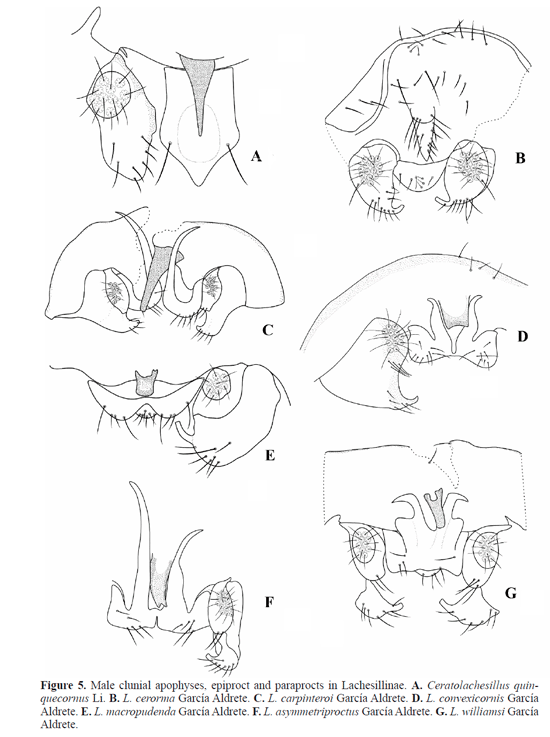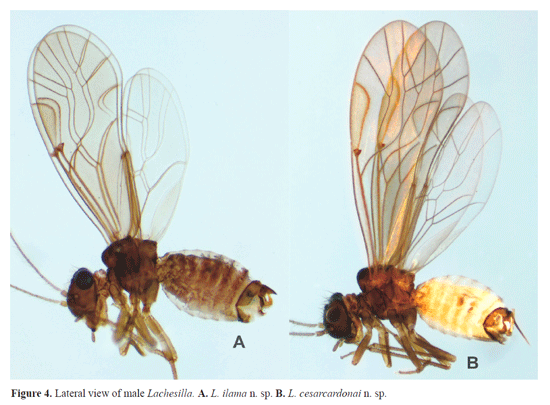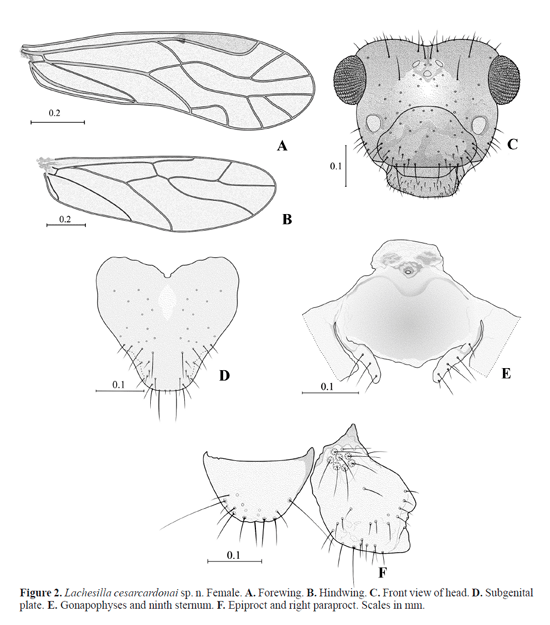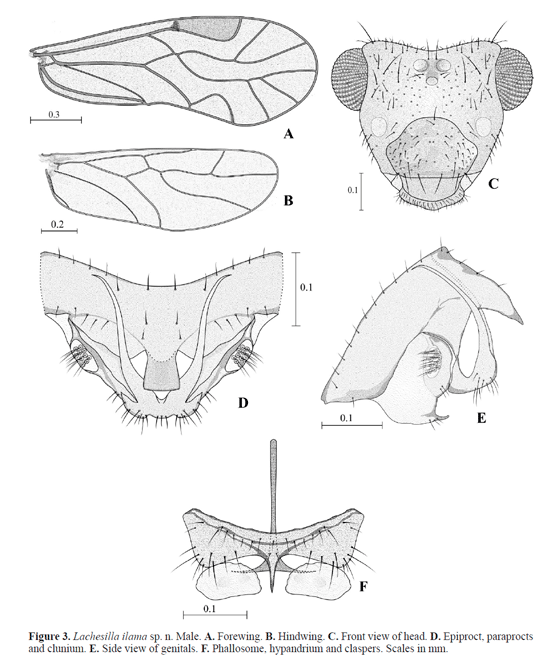Services on Demand
Journal
Article
Indicators
-
 Cited by SciELO
Cited by SciELO -
 Access statistics
Access statistics
Related links
-
 Cited by Google
Cited by Google -
 Similars in
SciELO
Similars in
SciELO -
 Similars in Google
Similars in Google
Share
Revista Colombiana de Entomología
Print version ISSN 0120-0488
Rev. Colomb. Entomol. vol.39 no.2 Bogotá July/Dec. 2013
Two new species of Lachesilla of Pedicularia group (Psocodea: 'Psocoptera'), from Valle del Cauca, Colombia
Dos especies nuevas de Lachesilla del grupo Pedicularia (Psocodea: 'Psocoptera'), del Valle del Cauca, Colombia
ALFONSO NERI GARCÍA ALDRETE1, RANULFO GONZÁLEZ OBANDO2 and CINTHYA SALDAÑA3
1 Ph. D. Departamento de Zoología, Instituto de Biología, Universidad Nacional Autónoma de México, Apartado Postal 70-153, 04510 México, D. F. México. anga@ib.unam.mx.
2 Ph. D. Departamento de Biología, Facultad de Ciencias Naturales y Exactas, Universidad del Valle, Santiago de Cali, Colombia. ranulfo. gonzalez@correounivalle.edu.co. Autor para correspondencia.
3 B. Sc. Departamento de Biología, Facultad de Ciencias Naturales y Exactas, Universidad del Valle, Santiago de Cali, Colombia. cinthya.saldaa88@gmail.com.
Received: 25-Jun-2013 - Accepted: 19-Dec-2013
Abstract: Two new species of Lachesilla, in species group Pedicularia, from Valle del Cauca, Colombia, are here described and illustrated. The males of these species present one mid clunial apophysis directed posteriorly. Species in group Pedicularia, in which the males have one mid clunial apophysis were previously known from the Departments of Cuzco and Madre de Dios, Peru. Males of Lachesilla with one mid clunial apophysis are known only in the Chinese Ceratolachesillus quinquecornus Li, and in the Mexican L. cerorma García Aldrete, in the latter, the clunial apophysis bears abundant setae, quite distinct from the glabrous, sclerotized apophyses of the other species.
Key words: Lachesillinae. Neotropics. Taxonomy. Clunial apophyses.
Resumen: Dos nuevas especies de Lachesilla, incluidas en el grupo Pedicularia, del Valle del Cauca, Colombia, son descritas e ilustradas. Los machos de estas especies presentan una apófisis clunial media dirigida posteriormente. Especies del grupo Pedicularia, en las cuales los machos poseen este tipo de apófisis han sido previamente conocidas del Departamento de Cuzco y Madre de Dios, Perú. Machos de Lachesilla con apófisis clunial media son conocidas solo en China, en Ceratolachesillus quinquecornus Li, y en México, en L. cerorma García Aldrete, en esta última, la apófisis clunial posee abundantes setas, muy diferente de las otras especies, en la cuales la apófisis es esclerosada y glabra.
Palabras clave: Lachesillinae. Neotrópico. Taxonomía. Apófisis clunial.
Introduction
In the Lachesillinae (Psocodea: 'Psocoptera': Lachesilli-dae), males with one mid clunial apophysis are known in the Chinese monotypic genus Ceratolachesillus Li (2002) (Fig. 5A), and in the cosmopolitan genus Lachesilla Westwood; and in the latter, only in species groups Cerorma (García Al-drete 2010) (Fig. 5B) and Pedicularia (García Aldrete 1974; Mockford 1993). In these two species groups, the clunial apophyses are of different nature: glabrous and sclerotized in the latter, and setose and not sclerotized in the former. The known species in the Pedicularia species group, in which the males have one mid clunial apophysis are Peruvian: L. carpinteroi García Aldrete, 2010 (Fig. 5C), and L. williamsi García Aldrete, 2010 (Fig. 5G), from Cuzco (García Aldrete 2010), and L. asymmetriproctus García Aldrete, 2008 (Fig. 4F), L. convexicornis García Aldrete (Fig. 5D), and L. macro-pudenda García Aldrete, 2008 (Fig. 5E), from the Tambopata Reserved Zone, in Madre de Dios (García Aldrete 2008).
We recently collected, in Valle del Cauca, Colombia, six males and one female of Lachesilla in species group Pedicularia, that represent two species; the males have one mid clu-nial apophysis over the area of the epiproct, and these species are different from the Peruvian ones indicated above. The purpose of this paper is to describe and illustrate the two new Colombian species.
Material and methods
Seven specimens, six males and one female, collected in the period 2009 - 2013, in three localities of the municipality of Santiago de Cali, Valle del Cauca, Colombia, were available for study. Four males and one female were dissected in 80% ethanol, and their parts (head, right wings and legs, and genitals), were mounted on slides in Canada Balsam. Color was recorded by placing whole specimens, before dissection, under a microscope illuminated with cold white light, at 50X. Parts on the slides were measured, following standard procedures, and the illustrations were made from digital photographs, taken with a Canon T3i camera and Helicon Focus program, processed in a vector graphics editor CorelDraw.
Abbreviations of parts measured are as follows: FW and HW: lengths of right fore -and hind- wings, F, T, t1 and t2: lengths of femur, tibia and tarsomeres 1 and 2 of right hind leg, respectively, ctt1: number of ctenidobothria on t1, Mx4: length of fourth palpomere of right maxillary palpus, f1.. .fn: lengths of flagellomeres 1...n of right antenna, IO, D and d: minimum distance between compound eyes, antero-posterior diameter and transverse diameter of right compound eye, respectively, on dorsal view of head, PO: d/D.
The specimens studied are deposited in the Entomological Museum, Universidad del Valle (MUSENUV), Santiago de Cali, Colombia.
Results
Lachesilla cesarcardonai sp. n. (Figs. 1, 2 and 4B)
Diagnosis: Belonging in species group Pedicularia (García Aldrete 1974; Mockford 1993). Differing from all the other species in species group Pedicularia, in which the males have one mid clunial apophysis (see above), in that the apophysis is very long, slender and acuminate, the posterior border of the clunium is concave, the sides forming slender extensions that join the antero-lateral corners of the epiproct.
Description. Male. Color (in 80% ethanol). Body reddish brown (Fig. 4B). Compound eyes black, ocelli hyaline, with ochre centripetal crescents. Wings almost hyaline, veins brown. Abdomen yellowish, with reddish brown subcuticular rings, less pigmented ventrally.
Morphology. Forewings 2.9 times as long as wide; pterostigma wider posteriorly, 3.3 times as long as wide. Veins Rs and M joined by a short crossvein (Fig. 1A). Areola postica broadly triangular, wide based, apically rounded. Hindwings 3.1 times as long as wide (Fig. 1B). Clunium with a long, slender apophysis in the middle, about eight times as long as its basal width, directed caudally, between the long epiproctal processes, directed backwards (Figs. 1D-1E).
Claspers long, subelliptic, with inner border bly sclerotized, with setae as illustrated (Fig. 1F); distal ends short, stout. Hypandrium small, membranous, joined laterally to each clasper; phallosome apodeme long, slender, distally divided in two arms, each ending in an elliptic membranous area (Fig. 1F). Paraprocts of two pieces, the proximal one joining the clunium, sensory fields with 14 trichobothria on basal rosettes, and one marginal trichobothrium without basal rosette; distal piece with a small sclerotized prong, distally truncate (Figs. 1D-1E).
Measurements (in um) FW: 2250, HW: 1725, F: 410, T: 730, t1i 210, t2: 102, ctt1: 16, Mx4: 105, 210, fj: 210, f,: 170, 90, f5: 80, 80, f?: 80, f8: 80, f,: 80, f^: 80, fa: 100, IO: 370, D: 110, d: 160, IO/d: 2.3, PO: 1.4.
Female. Color. As in the male. Subgenital plate, ninth sternum and valves dark brown.
Morphology. Forewings 3.3 times as long as wide; pterostigma as in the male, 3.5 times as long as wide; veins Rs and M joined by a short crossvein (Fig. 2A). Hindwing as in the male, 3.2 times as long as wide (Fig. 2B). Subgenital plate long, broad, setose as illustrated (Fig. 2D), with posterior border straight and pigmented area slightly cleft anteriorly. Ninth sternum pigmented, rounded anteriorly, spermapore towards anterior border, with a pigmented rim, close to two pigmented areas near the border (Fig. 2E). Gonapophyses elongate, slightly curved, directed posteriorly, with apex blunt, and 3 - 6 setae in a longitudinal row. Paraprocts broad, subelliptic, with setae as illustrated, sensory fields with seven trichobothria on basal rosettes, and one marginal trichoboth-rium without basal rosette (Fig. 2F). Epiproct trapeziform, with setae as illustrated (Fig. 2F).
Measurements (in urn). FW: 1650, HW: 1300, F: 340, T: 600, t1: 167, t2: 80, crt.1: 12, Mx4: 97, ft: 140, f2: 135, ft: 110, f4: 92, f5: 65, f6: 65, ft: 55, ft: 60, ft: 57, fw: 65, fn: 80, IO: 310, D: 70, d: 120, IO/d: 2.5, PO: 1.7.
Specimens studied: Holotype COLOMBIA. Valle del Cauca, Santiago de Cali, San Antonio, Finca San Francisco, 22.ix.2012, R. González (MUSENUV). Paratypes: 1$, same data as the holotype (MUSENUV). 1$, same locality and collector as the holotype 29.ix.2012. (MUSENUV).
Etymology. This species is dedicated, as a small post-obitum homage, to the Colombian entomologist César Cardona, who devoted his life to the study and understanding of insect pests in commercial agroecosystems.
Lachesilla ilama sp. n. (Figs. 3 and 4A)
Diagnosis. Belonging in species group Pedicularia (García Aldrete 1974; Mockford 1993). Differing from the Peruvian species having male mid clunial apophyses as follows: from L. assymetriproctus in having the epiproctal processes symmetric, and in having the clunial process much broader; differing from L. carpinteroi in having the distal ends of the claspers fused and pointed, and in having the clunial process much broader; differing from L. convexicornis in having the epiproctal processes much longer and slender, in having the distal ends of the claspers pointed, and in having the clunial process much longer, extending beyond the posterior border of the clunium; differing from L. macropudenda in having the distal ends of the claspers fused and pointed, and in having the clunial process broader and longer, in addition, L. macropudenda lacks epiproctal processes; differing from L. williamsi in having the epiproctal processes much longer and slender, in having the distal processes of the claspers fused, and in having the clunial process much longer and broader.
Description. Male. Color (in 80% ethanol). Body reddish brown (Fig. 4A). Compound eyes black, ocelli hyaline, without pigmented centripetal crescents. Wings hyaline, veins brown. Abdomen pale brown, with dark brown subcuticular rings, less pigmented ventrally.
Morphology. Forewings 2.6 times as long as wide; pterostigma wider posteriorly, 2.6 times as long as wide; veins Rs and M fused for a short length. Areola postica broadly triangular, wide, apically rounded (Fig. 3A). Hindwings 3.1 times as long as wide (Fig. 3B). Clunium with a median, stout, broad process, with posterior border straight (Figs. 3D-3E). Distal ends of the claspers fused to form a pointed process (Fig. 3F). Phallosome apodeme long, slender, distally dilated and divided in two arms apically pointed, each directed laterally and ending in a round membranous area (Fig. 3F). Paraprocts of two pieces, a proximal one elliptic and joined to clunium; distal piece with a sclerotized, curved mesal prong; sensory fields with 11 trichobothria issuing from basal rosettes, and one marginal trichobothrium without basal rosette (Figs. 4D-4E). Epiproct with two well defined halves, each with a long, curved, distally acuminate process (Fig. 3D).
Measurements (in urn). FW: 1700, HW: 1325, F: 340, T: 630, 217, t2: 90, cft: 19, Mx4: 75, 190, 160, f3: 150, f,: 120, 80, f6: 70, f,: 70, f8: 70, 70, fw: 80, fu: 90, IO: 290, D: 100, d: 160, IO/d: 1.8, PO: 1.6.
Specimens studied. Holotype $. COLOMBIA.
Valle del Cauca, Santiago de Cali, La Buitrera, 26.xii.2010, R. González. (MUSENUV). Paratypes: 1$, same locality and collector as the holotype, 23.i.2011. (MUSENUV). 1$, same locality and collector, 1.v.2013 (MUSENUV). 1$, Santiago de Cali, Parque Las Garzas, 21.i.2009 (MUSENUV).
Etymology. The specific name is a tribute to the Ilamas, an ethnic group that inhabited, from 1500-0 B. C., in what is now Valle del Cauca.
Discussion
Species of Lachesilla in the Pedicularia group, in which the males have one mid clunial apophysis, were known only from the Departments of Cuzco and Madre de Dios, Peru. They are here now recorded in Colombia. Several Afro-Eurasian species of Lache-silla in the Pedicularia group have males with two clunial apophyses (see García Aldrete 2010). The function of these apophyses is unknown.
The assemblage of species in the Pedicularia group, with males having one mid clunial apophysis is strictly South American; the species in it have the phallosome, hypandrium and claspers built on the same plan, and, except for L. macropudenda, all have the male epiproct with two curved processes directed backwards, flanking the clunial apophysis. These species can be separated on basis of the shape of the clunial apophysis, the shape of the epiproct, the posterior border of the clunium, and the distal ends of the claspers, either fused or independent.
These seven species are quite distinct from Ceratolache-sillus quinquecornus Li, and from L. cerorma García Aldrete, that belongs in a different species group. In the species assemblage referred above, L. caesarcardonai and L. macropudenda stand apart from all the others: the former, on account of the very long and slender acuminate apophysis, and by having the clunium extended posteriorly, next to each para-proct, to join each antero-lateral corner of the epiproct, and the latter, on account of lacking epiproctal processes. L. ila-ma is closer to L. convexicornis than to the other species in the assemblage, on basis of the broad clunial apophyses, and by having the distal ends of the claspers fused.
Acknowledgements
This work was financed by a grant to the authors (Project CI 7874), from the Universidad del Valle, Santiago de Cali, Colombia (Project CI 7874), to survey the Psocoptera of Valle del Cauca, Colombia. ANGA thanks Instituto de Biología, Universidad Nacional Autónoma de México, México City, México, for continuous research support. RGO and CS thank Departamento de Biología, Facultad de Ciencias Naturales y Exactas, Vicerectoría de Investigaciones, Universidad del Valle, Santiago de Cali, Colombia, for research support.
Literature cited
GARCÍA ALDRETE, A. N. 1974. A classification above species level of the genus Lachesilla Westwood (Psocoptera: Lachesillidae). Folia Entomológica Mexicana 27: 1-88. [ Links ]
GARCÍA ALDRETE, A. N. 2008. Lachesillidae (Insecta: Psocoptera) from the Tambopata Reserved Zone, Madre de Dios, Perú. Publicaciones Especiales del Instituto de Biología 21. Universidad Nacional Autónoma de México. México, D. F. 92 p. [ Links ]
GARCÍA ALDRETE, A. N. 2010. New Lachesilla (Psocodea: 'Psocoptera': Lachesillidae) from Peru and Mexico, based on males with one clunial apophysis. Revista Mexicana de Biodiversidad 81: 309-314. [ Links ]
LI, F. 2002. Psocoptera of China. National Natural Science Foundation of China. Two volumes (in Chinese). 1976 p. [ Links ]
MOCKFORD, E. L. 1993. North American Psocoptera (Insecta). Flora and Fauna Handbook No. 10. Sandhill Crane Press, Inc. Gainesville, Florida. Leiden. 455 p. [ Links ]
Suggested citation:
GARCÍA ALDRETE, ALFONSO NERI; RANULFO GONZÁLEZ OBANDO and CINTHYA SALDAÑA. 2013. Two new species of Lachesilla of Pedicularia group (Psocodea: 'Psocoptera'), from Valle del Cauca, Colombia. Revista Colombiana de Entomología 39 (2): 237-242.


















